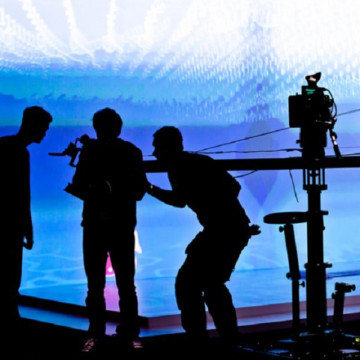

Year 11 Media Units 1 and 2
Overview
Course Overview:
In VCE Media Studies, students will explore a wide range of media forms, including film, television, digital media, audio media and social media. Students will learn to deconstruct and critically analyse media texts, identifying key elements such as narrative structure, visual techniques, sound design, and representation. They will develop an understanding of how media constructs meaning and influences audiences.
Through hands-on projects, students will develop their creative skills in media production. This includes writing, directing, filming, and editing their own media products, such as short films, documentaries, and digital content.
The subject also explores the relationship between media and society, including issues of media ethics, cultural representation, media ownership, and the impact of media on identity, politics, and social change.
The study is made up of four units.
Unit 1: Media forms, representations and Australian stories
Unit 2: Narrative across media forms
Areas of study:
- Media Representations: How do we see ourselves and our world in media products? This outcome looks at how media products and messages are constructed and received or understood by audiences through the process of selection, omission, construction and interaction.
- Media forms in production: How can we manipulate codes and conventions to create representations? Here you explore the stages of the media production process to create, develop and construct a media product for a specific audience.
- Australian Stories: How are Australian stories structured in fictional and non-fictional media narratives? We explore how the structural features of Australian fiction and non-fictional narratives engage audiences and how those features are read and consumed by an audience.
- Narrative style and Genre: How do media creators develop their style? We explore how media creators and producers construct realities and meaning with their narratives and how those narratives are received and consumed by an audience.
- Narratives in production: How can we use the production process to create our own media narratives? You explore the stages of the media production process to create, develop and construct a narrative for a specific audience.
- Media and change: What is the impact of new media technologies on us as individuals and as a society? This outcome looks at new media technologies and how they are changing the way we receive and distribute information, and examines the issues that are arising from these changes.
Who is it for?
Media is for students with an open and inquiring mind, who are both academic and creative.
If you want to further your knowledge and understanding of the media industry and create media products, this is the subject for you.
Media is the ideal subject if you have a passion for filmmaking, photography, digital design, communications, or animation. You should also be interested in how the media works and its influence on audiences.
What do you do?
Some of the activities include:
- plan a media product, including a design plan and storyboarding
- produce your own film, photography, animation or magazine
- share your media experiences
- interact and collaborate online with other media students
- attend online media classes
- edit and manipulate media texts to create meaning
- construct written responses to films, documentaries and visuals
- analyse advertisements, film/TV and print media.
What skills do you need?
There are no prerequisites, but you need to have:
- excellent communication skills
- excellent time-management skills
- some experience with editing software such as Photoshop, Premiere, Gimp, Movie maker, Audacity etc
- some experience with using a DLSR or video camera.
What skills do you develop?
You will develop skills including:
- applying the media production process to create, develop and construct narratives
- analysis of the construction of media texts and their messages to an audience
- critical thinking regarding the relationships between media technologies, media products and the society that produced them
- analysis of the intentions of media creators and producers and the influences of narratives on an audience
- working in a collaborative manner and to specific production roles.
Requirements
You must have a computer with internet access. You must attend online classes and own a headset with a microphone.
You will need personal access to the relevant equipment and software for your chosen media form, for example:
- photography form: hardware such as still camera and software such as Photoshop
- film/video/animation form: hardware such as a video camera, tripod and editing software such as Adobe Premiere
- print form: hardware such as still camera and software such as Adobe InDesign, Adobe Illustrator.
audio form:
- recording equipment,
- microphone,
- editing software such as Audacity.
You will need to be aware of the health and safety obligations in regard to yourself, your environment and others.
Things to think about
Media is very popular but also very challenging. In order to successfully complete both Units, you will need to commit to undertaking a substantial amount of work outside the course lessons. This work should focus on practicing and developing your skills in chosen mediums such as using Photoshop, filming, taking photos and editing.
You will also need to keep up to date with your weekly work submissions and keep in regular contact with your teacher. You should spend at least 6-8 hours a week on your media work.
You will submit your work online. You can communicate through phone, text, email, online lessons, screencasts and VSV Online. Your teacher can send links, extra resources, remind you of deadlines and respond to your questions quickly.
Things you can do now
Familiarise yourself with media/art products – advertising, music videos, photography, quality TV shows, YouTube videos, Tumblr, Instagram, short films, animations, etc, and find inspiration for your own media product.
Experiment with different software such as Photoshop, Final Cut Pro, etc, and creating different media forms, such as films, photography, print, etc.
Get started by looking at some of the tutorials below:
- Basics in Photoshop
- Best Photoshop tutorials
- Youtube Photoshop tutorials
- Gimp tutorials
- Basic use of Gimp
- How to draw in Gimp
- Final Cut Pro X Tutorials
- Final Cut Pro X for Beginners
- Final Cut Pro X-Full Class
- Camera Techniques
- Video Production
- Photography Techniques
- Digital Camera Techniques
- Useful Photography
Go to the VCAA website for more information about this subject.